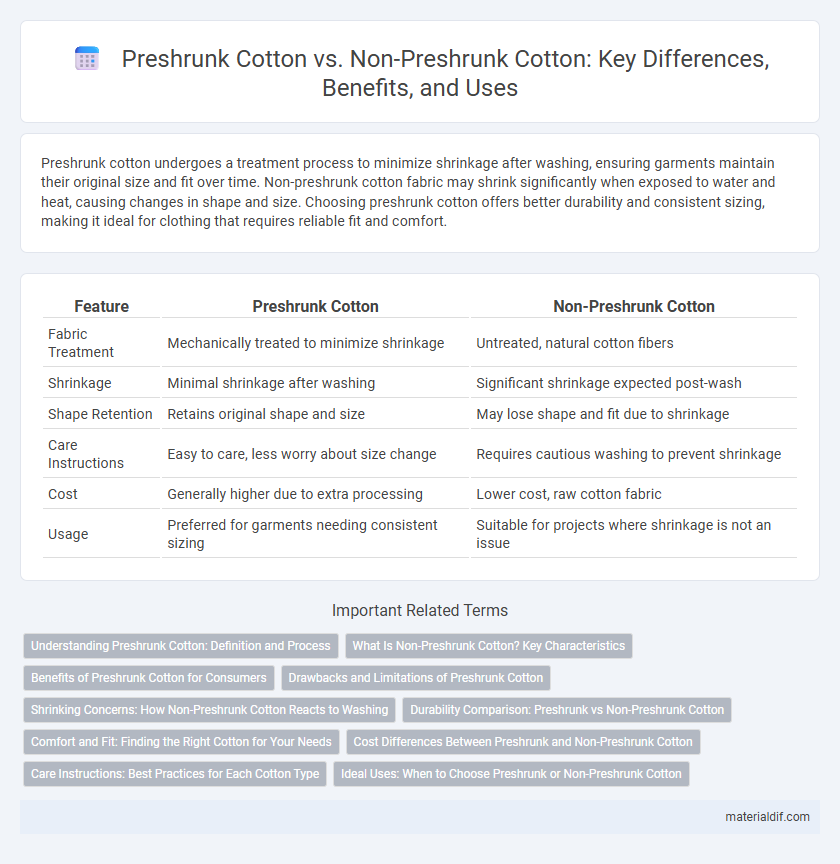Preshrunk cotton undergoes a treatment process to minimize shrinkage after washing, ensuring garments maintain their original size and fit over time. Non-preshrunk cotton fabric may shrink significantly when exposed to water and heat, causing changes in shape and size. Choosing preshrunk cotton offers better durability and consistent sizing, making it ideal for clothing that requires reliable fit and comfort.
Table of Comparison
| Feature | Preshrunk Cotton | Non-Preshrunk Cotton |
|---|---|---|
| Fabric Treatment | Mechanically treated to minimize shrinkage | Untreated, natural cotton fibers |
| Shrinkage | Minimal shrinkage after washing | Significant shrinkage expected post-wash |
| Shape Retention | Retains original shape and size | May lose shape and fit due to shrinkage |
| Care Instructions | Easy to care, less worry about size change | Requires cautious washing to prevent shrinkage |
| Cost | Generally higher due to extra processing | Lower cost, raw cotton fabric |
| Usage | Preferred for garments needing consistent sizing | Suitable for projects where shrinkage is not an issue |
Understanding Preshrunk Cotton: Definition and Process
Preshrunk cotton is fabric that has undergone a controlled shrinking process before being cut and sewn, minimizing further shrinkage after purchase. This treatment involves steaming or washing the cotton at the manufacturing stage to stabilize the fibers and preserve garment size consistency. Non-preshrunk cotton lacks this treatment, often resulting in noticeable shrinkage following the first wash.
What Is Non-Preshrunk Cotton? Key Characteristics
Non-preshrunk cotton refers to fabric that has not undergone any shrinking treatment after being woven, causing it to shrink when washed for the first time. This type of cotton retains its natural fibers' elasticity, making it more prone to size reduction, typically around 5-10%. Non-preshrunk cotton is often less expensive, offering a softer texture initially but requires careful washing to maintain garment dimensions.
Benefits of Preshrunk Cotton for Consumers
Preshrunk cotton offers consumers enhanced garment stability by minimizing post-wash shrinkage, ensuring consistent fit and comfort. This treatment preserves fabric durability, reducing the likelihood of distortion or misshaping over time. Choosing preshrunk cotton garments results in better value and longevity due to their maintained sizing and appearance after repeated laundering.
Drawbacks and Limitations of Preshrunk Cotton
Preshrunk cotton often has reduced shrinkage, but its drawback includes a slightly altered texture that may feel less soft compared to non-preshrunk cotton. The preshrinking process can also weaken fabric fibers, leading to lower durability and potential for quicker wear over time. Moreover, preshrunk cotton garments typically come at a higher cost, reflecting the additional manufacturing process.
Shrinking Concerns: How Non-Preshrunk Cotton Reacts to Washing
Non-preshrunk cotton fabrics are prone to noticeable shrinkage when exposed to washing and drying, typically shrinking between 3% to 5% in size. This reaction occurs because the fibers have not undergone any pre-shrinking treatments, causing them to contract under heat and agitation. Consumers often experience changes in garment fit and texture with non-preshrunk cotton, making preshrunk options preferable for consistent sizing.
Durability Comparison: Preshrunk vs Non-Preshrunk Cotton
Preshrunk cotton undergoes a controlled washing process that reduces the likelihood of significant shrinkage, resulting in fabrics that maintain their shape and size after multiple washes. Non-preshrunk cotton, untreated for shrinkage, often experiences notable changes in dimensions, which can weaken the fabric's fibers over time due to repeated agitation and stress. Consequently, preshrunk cotton tends to offer enhanced durability and longevity compared to non-preshrunk cotton, making it a preferred choice for garments and textiles requiring consistent fit and structural integrity.
Comfort and Fit: Finding the Right Cotton for Your Needs
Preshrunk cotton offers enhanced comfort and fit by minimizing fabric shrinkage after washing, ensuring garments maintain their original size and shape. Non-preshrunk cotton may shrink with the first wash, potentially altering fit and leading to discomfort or tighter clothing. Selecting preshrunk cotton is ideal for those seeking consistent sizing and long-lasting comfort in their apparel.
Cost Differences Between Preshrunk and Non-Preshrunk Cotton
Preshrunk cotton typically costs more than non-preshrunk cotton due to the additional processing steps required to reduce fabric shrinkage before manufacturing. This extra treatment increases production time and labor, leading to higher prices for preshrunk cotton garments. Non-preshrunk cotton, while more cost-effective initially, may shrink after washing, potentially increasing long-term expenses due to garment replacement or alteration.
Care Instructions: Best Practices for Each Cotton Type
Preshrunk cotton offers the advantage of minimal shrinking after washing, allowing for straightforward care using cold water and low heat drying to maintain fabric integrity. Non-preshrunk cotton requires gentler handling, including washing in cold water and air drying or tumble drying on low heat to prevent significant shrinkage and maintain garment size. Following these specific care instructions ensures longevity and optimal appearance for each type of cotton fabric.
Ideal Uses: When to Choose Preshrunk or Non-Preshrunk Cotton
Preshrunk cotton is ideal for garments requiring a consistent fit, such as tailored shirts and fitted dresses, as it minimizes shrinkage during washing and drying. Non-preshrunk cotton suits items where natural shrinkage is acceptable or desired, like casual T-shirts or bath towels that may soften and contour over time. Choosing between preshrunk and non-preshrunk cotton depends on the importance of maintaining size stability versus embracing the fabric's natural change with use.
Preshrunk Cotton vs Non-Preshrunk Cotton Infographic

 materialdif.com
materialdif.com